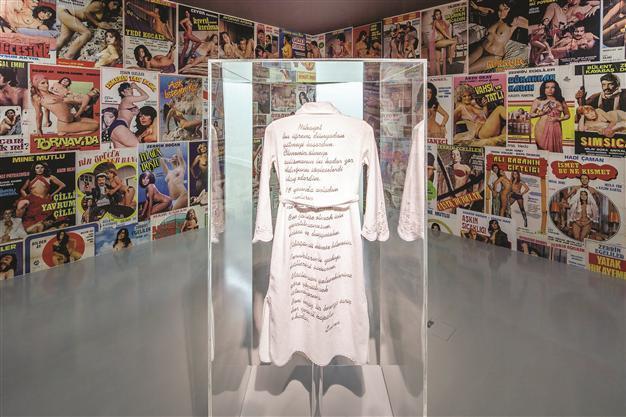Arter exhibition delves into social memory
ISTANBUL - Hürriyet Daily News

The exhibition explores destructive feelings that mankind cautiously conceal as well as the traumas associated with them.
Emotional vices are reflected in an exhibition, titled “Envy, Enmity, Embarrassment,” opening today at Arter Art Space.The three terms in the title are keywords for expressing social, cultural and political memory within contemporary artistic discourse and initiate an intellectual process resulting in the creation and production of a series of new artwork. The exhibition aims to explore these three interconnected concepts that precede, follow and complete each other in a broad web of causality and wide perspective that incorporate diverse contexts ranging from political and social violence to the media; careerist concerns and ambitions to gender politics; and the potential for friendship and solidarity to that of aggressive and destructive drives. Revisiting a collective contemporary history marked by violence and disgrace, the exhibition explores destructive feelings that mankind cautiously conceal as well as the traumas associated with them.
A selection of diverse artists have contributed their work to the exhibition, including Selim Birsel, Hera Büyüktaşçıyan, CANAN, Aslı Çavuşoğlu, the duo of Merve Ertufan and Johanna Adebäck, Nilbar Güreş, Berat Işık, Şener Özmen, Yusuf Sevinçli, Erdem Taşdelen, Hale Tenger and Mahir Yavuz.
Exhibition pieces
Selim Birsel’s “Grown in the Backyard” (2012) is an installation that documents encounters between found objects and interventions or additions made to them, such as “Masquerade” (1998-9), “Blood Circulation” (1997), “Grabbing on to Life” (1998-99), and “Burden” (2000).
“The Missing Cuckoo” (2008) by Hera Büyüktaşçıyan is a manifestation of the artist’s struggle with consolidating personal memories, history and perceptions in terms of family, community and society, seen through a chronological lens.
CANAN’s installation, titled “I beg you please do not speak to me of love,” consists of a white bathrobe surrounded by a roomful of posters from erotic and pornographic films, which constituted the main artery of the Turkish film industry in the 1970s. CANAN notes the imposed border between the observer and the observed and the misleading nature of the ebb and flow between the two, something that – in the artist’s eyes – is a suicide note embroidered on a white bathrobe.
The uniqueness of Aslı Çavuşoğlu’s installation “Gordian Knot” (2013) is the head of Alexander the Great. In producing yet another replica of this well-known sculpture, she divided the whole into two pieces and then places the two halves back together, with a twist. Sculptures of Alexander the Great are perhaps the most symbolic indicators of the ongoing animosity between Greece and the Republic of Macedonia, and the artist attempts to touch on this relationship.
Nilbar Güreş’s collage by the name of “Twin Goddess: The Sketch of an Encounter,” revolves around a 9,000-year-old twin goddess figurine that she and her mother encountered during their visit to the Anatolian Civilizations Museum in Ankara.
The contribution by Berat Işık comes in the revisiting of an earlier piece titled “Hole” (2010). Projected onto the end of a narrow corridor, the new version of the video incorporates space as an integral element and concentrates on an almost endoscopic vision, leaving behind the narrative character of the original.
In Şener Özmen’s “Pole Escaping Its Flag,” two flagpoles stripped of their flags rise up in perfect symmetry as if mirroring each other.
In his new series entitled “Idol,” Yusuf Sevinçli explored sculptures and monuments in public spaces, particularly those that have been vandalized. He claims to hover – as opposed to focus – on the monuments, as the subject matter of his work is quintessentially out of focus and de-centered.
Erdem Taşdelen approaches the issue of an artist’s authorship as a form of appropriation and a state of responsibility in the sphere of co-existence. Running a thorough investigation into his personal, public and psychological baggage, he embarks on a journey of self-discovery in the company of a therapist who helped him gain an external view of himself.
“I Know People Like This III” by Hale Tenger acts as an archival gateway as a luminous, labyrinthine installation snaking throughout the building in a series of corridors. The tall walls are lightboxes reminiscent of negatoscope screens used to view x-rays. Featuring different-sized x-ray prints organized in neutral grids, the installation displays a chronological selection of photographs that testify to Tenger’s interpretation of “state violence.”
Mahir Yavuz employed a method of data analysis in his contribution to the exhibition, reflecting his area of professional expertise, to follow the traces of discriminatory discourse in the online archive of a newspaper.
Also featured in the exhibition are artists Johanna Adeback and Merve Ertufan, who have been producing art together since 2009 as part of a joint project, titled “Me and You.”
“Envy, Enmity, Embarrassment” will be on display until April 7.
















